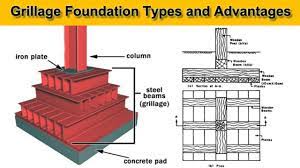In the realm of civil engineering and construction, the importance of a solid foundation cannot be overstated. One innovative solution that has gained prominence for its efficiency and stability is the grillage foundation. This specialized foundation system utilizes a grid of beams and slabs to distribute loads effectively and ensure the stability of structures. This article explores the principles, advantages, and applications of grillage foundations, shedding light on their significance in modern construction practices.
Understanding Grillage Foundation:
A grillage foundation is a type of shallow foundation that consists of a grid or framework of beams and slabs constructed to evenly distribute loads to the underlying soil. The grid structure resembles a grill, giving the foundation its name. Grillage foundations are commonly used in situations where traditional spread footings may be impractical due to soil conditions or where a more efficient load distribution system is required.
Principles of Grillage Foundation Design:
The design of a grillage foundation is based on the principles of load distribution and soil mechanics. The load from the structure is transferred through the beams and slabs to the soil beneath, ensuring that the pressure on the soil does not exceed its bearing capacity. The arrangement and spacing of the grid elements are determined based on the expected loads and soil characteristics.
Components of a Grillage Foundation:
A typical grillage foundation comprises primary beams, secondary beams, and slab elements. Primary beams are placed directly beneath the load-bearing walls or columns, while secondary beams connect the primary beams to form a grid pattern. The slab elements complete the grid, providing a surface for load distribution. The materials used for these components depend on the structural requirements and the characteristics of the site.
Advantages of Grillage Foundations:
Grillage foundations offer several advantages over traditional foundation systems. Their efficient load distribution minimizes settlement and ensures uniform support across the structure. The shallow depth of grillage foundations makes them suitable for sites with challenging soil conditions. As they can distribute loads over a larger area.
Applications in Bridge Construction:
Grillage foundations are widely used in bridge construction, especially for supporting piers and abutments. The ability to distribute heavy loads evenly makes grillage foundations an ideal choice for ensuring the stability and longevity of bridge structures. The modular nature of the grillage system also facilitates ease of construction in challenging environments.
Utilization in Industrial Structures:
Industrial structures, such as large manufacturing plants or warehouses, often require robust foundations to support heavy machinery and equipment. Grillage foundations prove effective in such settings, offering a reliable solution for distributing concentrated loads and ensuring the stability of the industrial structures.
Adaptability to Varied Soil Conditions:
Grillage foundations are known for their adaptability to different soil conditions. Whether dealing with expansive soils, loose or dense sands, or clayey soils. The flexibility in design and construction allows engineers to tailor grillage foundations to meet the specific challenges posed by the site’s soil characteristics.
Reduced Settlement Concerns:
Settlement is a common concern in construction, especially in areas with soft or compressible soils. Grillage foundations, with their ability to distribute loads over a larger area, help mitigate settlement issues. This is particularly crucial in structures where differential settlement could lead to structural damage or uneven settlement.
Cost-Effectiveness and Time Efficiency:
The modular and standardized nature of grillage foundation construction contributes to cost-effectiveness and time efficiency. The use of precast or prefabricated components allows for quicker assembly on-site, reducing construction time and associated costs. This efficiency is particularly advantageous in projects with tight timelines.
Considerations in Design and Construction:
Designing and constructing grillage foundations requires careful consideration of factors such as soil-bearing capacity, expected loads, and the geometry of the structure. Soil testing and analysis are essential to determine the appropriate spacing and dimensions of the grid elements. Additionally, construction practices must adhere to engineering standards and quality control measures.
Conclusion:
Grillage foundations, with their grid-like structure and load-distributing capabilities, stand as a testament to the innovation and adaptability within the field of civil engineering. Their versatility in addressing various soil conditions and providing stable foundations for diverse structures makes them a valuable solution in modern construction practices. As engineers continue to push the boundaries of design and construction. Grillage foundations remain a reliable and efficient choice for reinforcing the roots of stability in a wide range of projects.

